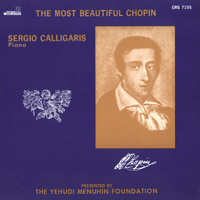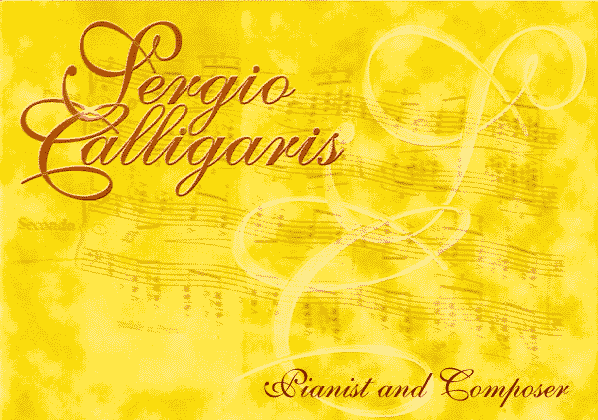 THE MOST BEAUTIFUL CHOPIN
THE MOST BEAUTIFUL CHOPIN
Sergio Calligaris at piano
[LP: Orion Records, stereo ORS 7155]
SIDE 1
Etude in C minor, Op. 10 N.12 (2'48")
Impromptu in F sharp major, Op.36 (6'51")
Polonaise in A flat major, Op.53 (7'29")
SIDE 2
Impromptu in G flat major, Op.51 (6'00")
Valse brillante in A flat major, Op.34 N.1 (5'37")
Nocturne in E flat major, Op.9 N.2 (5'15")
The Impromptu in G flat major op.51 is one of Frederick Chopin's
(1810-1849) most beautiful and sophisticated compositions, especially in the harmonic
sequences, so rich in flexible nuances, ritards and unexpected modulations, that give this
work an extraordinary sinuosity of shape and an expressive and beautiful poetic
atmosphere. The mood, in spite of the key of G flat major, is that of a subdued autumnal
melancholy, characteristic of most of Chopin's mature compositions. The first section of
this Impromptu is based on themes of undulating lines, gentle accents and wandering
harmonies. The middle episode, with its cello-like melody, has an intense lyricism.
Very different is the mood set from the very first bars of the Waltz Brilliante in A
flat major, op.34 No.1. This delightful Waltz has much elegance in its first theme,
which follows the short and brilliant introduction. In the second theme it projects a
definite feeling of self-confidence that enhances even more the charm of the dance. Most
of the central section is on the more melodic side, with an outburst of intense feeling in
its secondary subject. Following the re-exposition of the leading themes, the coda is
fast, youthful and sparkling.
With the Nocturne in E flat major, op.9 No.2, we encouter Chopin as a creator of
melodies of superlative beauty, accompanied by the gentle rhythm of the left hand, and
rising towards the end to a great expressive climax, after which the music vanishes away
like a dream.
Roaring basses, dramatic accents, agitated figurations and a theme of great rhythmic
power and definition, make up that tremendously tragic musical picture that is the Etude
in c minor, op.10 No.12, also known as the Revolutionary Etude.
A true masterwork, the Impromptu in F sharp major, op.36 is one of the finest
expressions of Romanticism, and in some ways it almost anticipates the subtle coloristic
world of Impressionism. At the beginning, the voice of the poet is heard through a songful
theme, of deep sentiment and expressivity. Then, airy harmonies are heard far away,
floating in the pastoral atmosphere. The poet dreams of a procession of noblemen riding
slowly and solemnly, with expressionless faces. In his imagination the poet believes the
dream to be truth, as the figures of the noblemen seem to grow larger, more majestic,
always closer… all of a sudden the vision vanishes, the first theme returns, this
time surrounded by the gentle mood of the approaching evening. Towards the end we can
almost hear in the right hand the breeze whispering through the leaves, while an inspiring
melody, with its warm voices floats in the middle register of the piano… finally only
the distant harmonies heard before reappear calmly, to conclude this poetic picture.
The Polonaise in A flat major, op.53 ("Heroic") brings to the fore all
the patriotic fervor of Chopin, his rebellion against the oppressor, his visions of wars,
his reminiscences of idyllic days gone by… all this in a succession of episodes of
extraordinary character and delineation. The Polonaise closes with the majestic and
triumphant theme with which it began - a truly magnificent musical conception!
1971 ORION RECORDS

